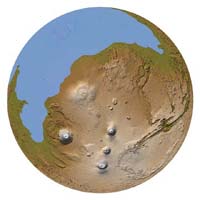| . |  |
. |
|
Possible Mars Shoreline Found  Providence - Dec. 9, 1999 - In an article to be published in Science magazine Dec. 10, 1999, Brown University planetary geologist James Head and five colleagues present topographical measurements which they say are consistent with an ocean that dried up hundreds of millions of years ago. The measurements were taken by the Mars Orbiter Laser Altimeter, an instrument aboard the unmanned spacecraft Mars Global Surveyor which is circling the planet.
Providence - Dec. 9, 1999 - In an article to be published in Science magazine Dec. 10, 1999, Brown University planetary geologist James Head and five colleagues present topographical measurements which they say are consistent with an ocean that dried up hundreds of millions of years ago. The measurements were taken by the Mars Orbiter Laser Altimeter, an instrument aboard the unmanned spacecraft Mars Global Surveyor which is circling the planet.Head's team set out to test the hypotheses of scientists who suggested the possibility of oceans on Mars in 1989 and 1991. The team used data from the Mars Orbiter Laser Altimeter, which beamed a pulsing laser to Mars' surface. In this topographic portrayal of Mars, above, the northern lowlands are occupied by an ocean (blue) whose shoreline is placed at the position of Contact 2, the line that Parker and co-workers interpreted as an ancient shoreline. Thus, this view shows Mars as it might have looked mid-way through its history according to the oceans hypothesis. The Tharsis region, with numerous very large shield volcanoes is seen in the central part of the globe. In the upper right, many channels flow into the northern lowlands at Chryse Planitia. Credit: MOLA Team. Rendering by Peter Neivert, Brown University. Scientists measured the time it took for the laser to return to the satellite; the laser traveled a shorter length of time from mountain peaks and longer from craters. MOLA is the first instrument to provide scientists the information required to construct a topographic map of the entire surface of the planet. For years, scientists have known about channels in which water once flowed into the northern lowlands on the surface of Mars. "The question is whether it collected in large standing bodies," Head said. "This is the first time we could get instruments to comprehensively test these ideas." According to Head, the team has found four types of quantitative evidence that points to the possible ancient ocean:
Head's team concludes that further tests are necessary, including analysis of meteorites from Mars and of landing sites, checking for the presence of salts that may be related to former oceans. The importance of determining whether there were ancient oceans -- and life -- on Mars is that scientists may be able to learn more about long-term climate change and why climate changed on Mars, which has relevance to the future of the Earth, Head said.
|
| |||||||||
| The content herein, unless otherwise known to be public domain, are Copyright 1995-2016 - Space Media Network. All websites are published in Australia and are solely subject to Australian law and governed by Fair Use principals for news reporting and research purposes. AFP, UPI and IANS news wire stories are copyright Agence France-Presse, United Press International and Indo-Asia News Service. ESA news reports are copyright European Space Agency. All NASA sourced material is public domain. Additional copyrights may apply in whole or part to other bona fide parties. Advertising does not imply endorsement, agreement or approval of any opinions, statements or information provided by Space Media Network on any Web page published or hosted by Space Media Network. Privacy Statement All images and articles appearing on Space Media Network have been edited or digitally altered in some way. Any requests to remove copyright material will be acted upon in a timely and appropriate manner. Any attempt to extort money from Space Media Network will be ignored and reported to Australian Law Enforcement Agencies as a potential case of financial fraud involving the use of a telephonic carriage device or postal service. |